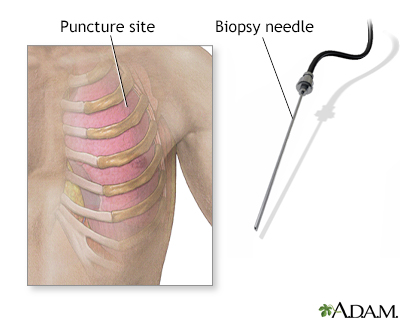Pleural needle biopsy
Closed pleural biopsy; Needle biopsy of the pleura
Pleural biopsy is a procedure to remove a sample of the pleura. This is the thin tissue that lines the chest cavity and surrounds the lungs. The biopsy is done to check the pleura for disease or infection.
Images

I Would Like to Learn About:
How the Test is Performed
This test may be done in the hospital. It may also be done at a clinic or health care provider's office.
The procedure involves the following:
- You will be sitting up during the procedure.
- Your provider cleanses the skin at the biopsy site.
- A numbing drug (anesthetic) is injected through the skin and into the lining of the lungs and chest wall (pleural membrane).
- A larger, hollow needle is then placed gently through the skin into the chest cavity. Sometimes, your provider uses ultrasound or CT imaging to guide the needle.
- A smaller cutting needle inside the hollow one is used to collect tissue samples. During this part of the procedure, you are asked to sing, hum, or say "eee." This helps prevent air from getting into the chest cavity, which can cause the lung to collapse (pneumothorax). Usually, 3 or more biopsy samples are taken.
- When the test is finished, a bandage is placed over the biopsy site.
In recent years, pleural biopsy is most often done using a fiberoptic scope. The scope allows your provider to view the area of the pleura from which the biopsies are taken.
How to Prepare for the Test
You will have blood tests before the biopsy. You will likely have a chest x-ray.
How the Test will Feel
When the local anesthetic is injected, you may feel a brief prick and a burning sensation. When the biopsy needle is inserted, you may feel pressure. As the needle is being removed, you may feel tugging.
Why the Test is Performed
Pleural biopsy is often done to find the cause of a collection of fluid around the lung (pleural effusion) or other abnormality of the pleural membrane. Pleural biopsy can diagnose tuberculosis, cancer, and other diseases.
If this type of pleural biopsy is not enough to make a diagnosis, you may need a surgical biopsy of the pleura.
Normal Results
Pleural tissues appear normal, without signs of inflammation, infection, or cancer.
What Abnormal Results Mean
Abnormal results may reveal:
- Primary lung cancer
- Malignant mesothelioma
- Metastatic pleural tumor
- Collagen vascular disease
- Tuberculosis
- Other infections
Risks
There is a slight chance of the needle puncturing the wall of the lung, which can partially collapse the lung. This usually gets better on its own. Sometimes, a chest tube is needed to drain the air and expand the lung.
There is also a chance of excessive blood loss.
Considerations
If a closed pleural biopsy is not enough to make a diagnosis, you may need a surgical biopsy of the pleura. This procedure has been mostly replaced by a procedure that uses a scope to visualize the pleura while taking the biopsy (pleuroscopy).
Related Information
Collagen vascular diseaseMetastatic pleural tumor
Lung cancer - small cell
References
Reed JC. Pleural effusions. In: Reed JC, ed. Chest Radiology: Patterns and Differential Diagnoses. 7th ed. Philadelphia, PA: Elsevier; 2018:chap 4.
Walsh R, Klein JS. Thoracic radiology: invasive diagnostic imaging and image-guided interventions. In: Broaddus VC, Ernst JD, King TE, et al, eds. Murray and Nadel's Textbook of Respiratory Medicine. 7th ed. Philadelphia, PA: Elsevier; 2022:chap 21.
BACK TO TOPReview Date: 8/13/2023
Reviewed By: Denis Hadjiliadis, MD, MHS, Paul F. Harron Jr. Professor of Medicine, Pulmonary, Allergy, and Critical Care, Perelman School of Medicine, University of Pennsylvania, Philadelphia, PA. Also reviewed by David C. Dugdale, MD, Medical Director, Brenda Conaway, Editorial Director, and the A.D.A.M. Editorial team.

Health Content Provider
06/01/2025
|
A.D.A.M., Inc. is accredited by URAC, for Health Content Provider (www.urac.org). URAC's accreditation program is an independent audit to verify that A.D.A.M. follows rigorous standards of quality and accountability. A.D.A.M. is among the first to achieve this important distinction for online health information and services. Learn more about A.D.A.M.'s editorial policy, editorial process and privacy policy. A.D.A.M. is also a founding member of Hi-Ethics. This site complied with the HONcode standard for trustworthy health information from 1995 to 2022, after which HON (Health On the Net, a not-for-profit organization that promoted transparent and reliable health information online) was discontinued. |
The information provided herein should not be used during any medical emergency or for the diagnosis or treatment of any medical condition. A licensed medical professional should be consulted for diagnosis and treatment of any and all medical conditions. Links to other sites are provided for information only -- they do not constitute endorsements of those other sites. © 1997- 2024 A.D.A.M., a business unit of Ebix, Inc. Any duplication or distribution of the information contained herein is strictly prohibited.
